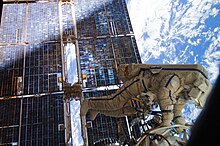
Back Ruimtewandeling AF نشاط خارج المركبة Arabic Açıq kosmosa çıxış AZ Излизане в открития космос Bulgarian Activitat extravehicular Catalan Výstup do vesmíru Czech Rumvandring Danish Außenbordeinsatz German Δραστηριότητα εκτός σκάφους Greek Eksterveturila agado EO


Extravehicular activity (EVA) is any activity done by an astronaut in outer space outside a spacecraft. In the absence of a breathable Earthlike atmosphere, the astronaut is completely reliant on a space suit for environmental support. EVA includes spacewalks and lunar or planetary surface exploration (commonly known from 1969 to 1972 as moonwalks). In a stand-up EVA (SEVA), an astronaut stands through an open hatch but does not fully leave the spacecraft.[1] EVAs have been conducted by the Soviet Union/Russia, the United States, Canada, the European Space Agency and China.
On March 18, 1965, Alexei Leonov became the first human to perform a spacewalk, exiting the Voskhod 2 capsule for 12 minutes and 9 seconds. On July 20, 1969, Neil Armstrong became the first human to perform a moonwalk, outside his lunar lander on Apollo 11 for 2 hours and 31 minutes. In 1984, Svetlana Savitskaya became the first woman to perform a spacewalk, conducting EVA outside the Salyut 7 space station for 3 hours and 35 minutes. On the last three Moon missions, astronauts also performed deep-space EVAs on the return to Earth, to retrieve film canisters from the outside of the spacecraft. American Astronauts Pete Conrad, Joseph Kerwin, and Paul Weitz also used EVA in 1973 to repair launch damage to Skylab, the United States' first space station.
EVAs may be either tethered (the astronaut is connected to the spacecraft; oxygen and electrical power can be supplied through an umbilical cable; no propulsion is needed to return to the spacecraft), or untethered. Untethered spacewalks were only performed on three missions in 1984 using the Manned Maneuvering Unit (MMU), and on a flight test in 1994 of the Simplified Aid For EVA Rescue (SAFER), a safety device worn on tethered U.S. EVAs.
- ^ NASA (2007). "Stand-Up EVA". NASA. Retrieved October 21, 2008.